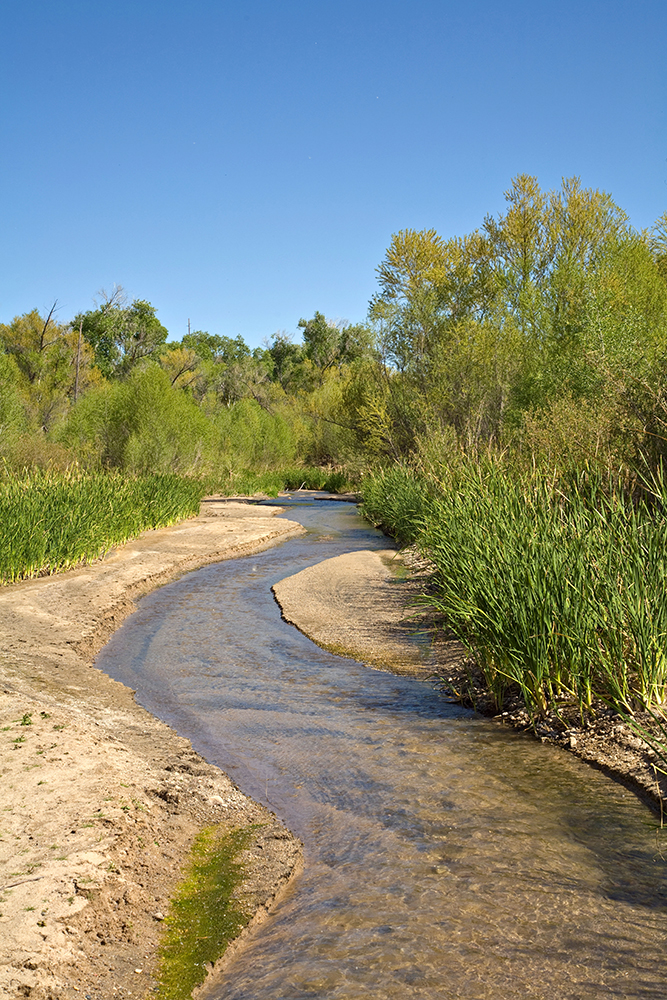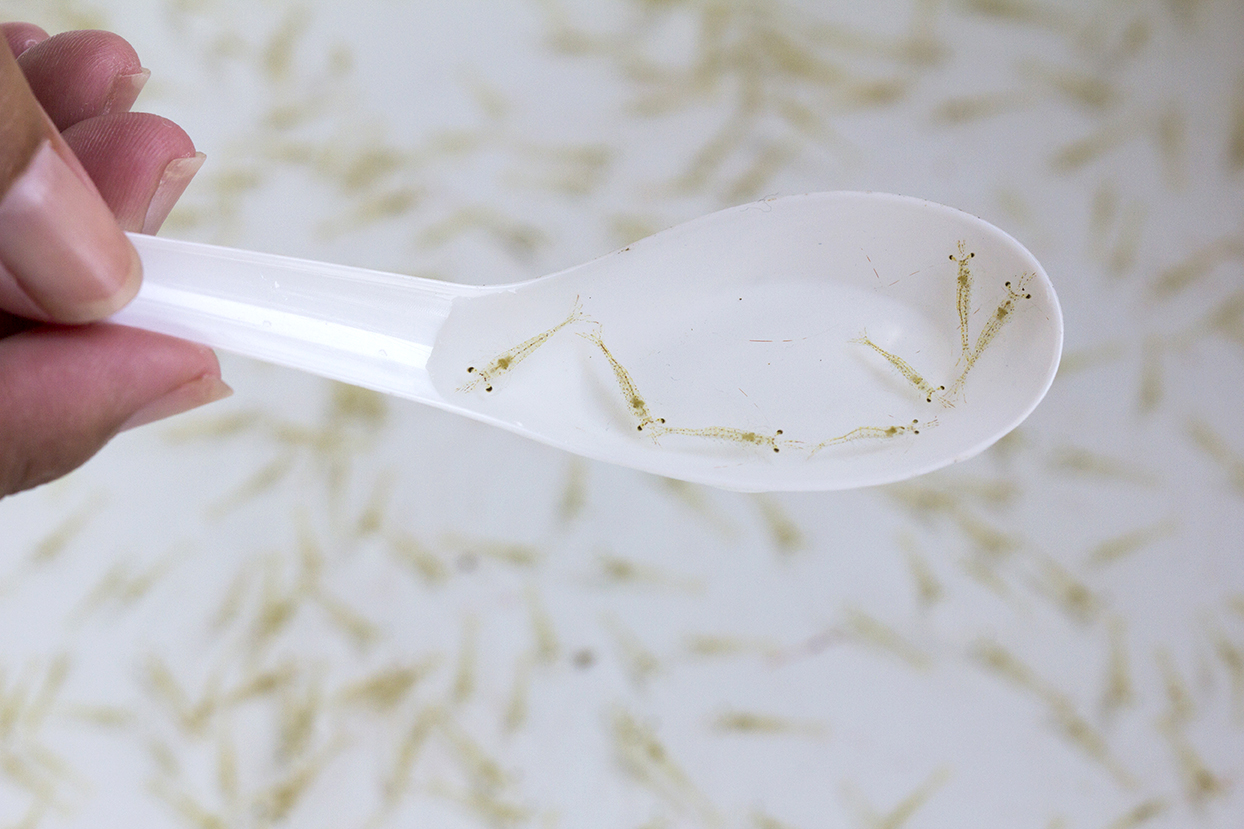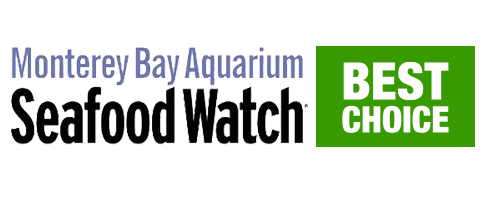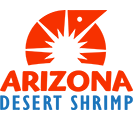Aquifer Water

The Hassayampa River is the source of groundwater that maintains one of the largest aquifers in Arizona making aquaculture and agriculture possible. The aquifer water is of critical importance and bares directly on the underlying reason why West Valley Farms was established in the Gila Basin, Arizona. Aquifer water has a saline content of 1.6-5.5 PPT (parts per thousand), i.e., 1.6-5.5 grams per thousand grams of solution. It is also worth noting that water flows through what an earthen filter and effectively microbe free until pumped to the surface.
Finding sustainably farmed shrimp requires looking at factors like water quality and what the shrimp get fed. As a basic rule, U.S. farmed shrimp are considered a “good alternative” by Seafood Watch because federal and state laws regulate water quality. U.S. farms also use 30 percent less feed for shrimp than most overseas processors. Feeding shrimp less yet higher-quality feed means a more efficient and healthier food production.
Pond
 All ponds are sloped to the center along the linear axis. In addition, the ponds are sloped along the linear axis towards a screened off pit area. The effect is when the water is lowered and the screen is removed the shrimp are concentrated. A large diameter flexible hose connected to a fish pump is then lowered into the water and the shrimp are pumped to a dewatering conveyor machine. The dewatered shrimp coming of the end of the conveyor belt are dropped into a perforated basket tub liner containing 4oC fresh water in which a polyphenol oxidase inhibitor is suspended and allowed to reside for ~10 minutes with agitation.
All ponds are sloped to the center along the linear axis. In addition, the ponds are sloped along the linear axis towards a screened off pit area. The effect is when the water is lowered and the screen is removed the shrimp are concentrated. A large diameter flexible hose connected to a fish pump is then lowered into the water and the shrimp are pumped to a dewatering conveyor machine. The dewatered shrimp coming of the end of the conveyor belt are dropped into a perforated basket tub liner containing 4oC fresh water in which a polyphenol oxidase inhibitor is suspended and allowed to reside for ~10 minutes with agitation.
After treatment the basket containing the shrimp is removed from the tank and transferred to another tank containing of 4oC fresh water. The suspended shrimp are stirred to remove any detritus and water is allowed to drain from the tank and shaved ice is layered over the shrimp before being transferred to the processing center.
When the desired amount of shrimp has been removed from the pond, water from the aquifer is used to restore the desired pond depth and grow out of the remaining shrimp can continue.
Processing
 Heads on Shell on (HOSO) shrimp fresh. Shrimp are taken out of quarantine and taken to wash down line. Shrimp are placed on conveyor belt, sprayed with clean water to remove any detritus (mud, vegetation, broken shrimp) and collected in a clean sanitized tub. The tub containing heads on shell on (HOSO) shrimp can be taken to in process center or directly to packaging area. In the packaging area Smart Tec tubs will be placed on a scale, tared and filled with 5 or 10 pounds of shrimp. A lid will then be applied to the tubs and moved into the cold-room ready for shipment.
Heads on Shell on (HOSO) shrimp fresh. Shrimp are taken out of quarantine and taken to wash down line. Shrimp are placed on conveyor belt, sprayed with clean water to remove any detritus (mud, vegetation, broken shrimp) and collected in a clean sanitized tub. The tub containing heads on shell on (HOSO) shrimp can be taken to in process center or directly to packaging area. In the packaging area Smart Tec tubs will be placed on a scale, tared and filled with 5 or 10 pounds of shrimp. A lid will then be applied to the tubs and moved into the cold-room ready for shipment.
Heads on Shell on (HOSO) shrimp previously frozen. Up to the point of packaging HOSO shrimp will be processed the same. For shrimp that will be subjected to individual quick-frozen (IQF) or flash frozen, large tubs that can hold 500 plus lb. of shrimp will be filled with shrimp interlayered with shaved ice. The HOSO will then be moved to an IQF machine for processing, i.e., the shrimp will be laid out on a conveyor belt and passed through a nitrogen freezing tunnel. After passing through the tunnel shrimp will be bagged and weighted and immediately taken to a -20oC freezer for storage until being shipped to client.
Headless Shell on (HLSO) shrimp fresh. Shrimp are taken out of quarantine and taken to wash down line. Shrimp are placed on conveyor belt, sprayed with clean water to remove any detritus (mud, vegetation, broken shrimp) and collected in a clean sanitized tub. The tub containing heads on shell on (HOSO) shrimp can be taken to in process where heads are removed producing head less shell on (HLSO) then packaged. In the packaging area Smart Tec tubs will be placed on a scale, tared and filled with 5 or 10 pounds of shrimp. A lid will then be applied to the tubs and moved into the cold-room ready for shipment.
Headless Shell on (HLSO) shrimp previously frozen. Shrimp are taken out of quarantine and taken to wash down line. Shrimp are placed on conveyor belt, sprayed with clean water to remove any detritus (mud, vegetation, broken shrimp) and collected in a clean sanitized tub. The tub containing heads on shell on (HOSO) shrimp can be taken to in process where heads are removed producing head less shell on (HLSO) shrimp. The HLSO shrimp will then be moved to the IQF line for processing, i.e., the shrimp will be laid out on a conveyor belt and passed through a nitrogen freezing tunnel. After passing through the tunnel shrimp will be bagged and weighted and immediately taken to a -20oC freezer for storage until being shipped to client.
Samples of shrimp produced by Process 1-4 will be removed for each batch and sent for microbiological assay. Results will be correlated with harvested batch.
A barcode will be assigned to each harvested batch of shrimp and read at each process step. An additional code will be added for processed shrimp indicating date of harvest, date of process, and date of storage. When shipped to client a code encompassing shipping date, client contact info will be correlated with the above for West Valley Farms.
Traceability
 Efficient Farming. With detailed data- and analytics-based records for each step along the supply chain, shrimp farms and production facilities can streamline operations, thereby increasing production volumes. Traceability can increase operational efficiency through record keeping.
Efficient Farming. With detailed data- and analytics-based records for each step along the supply chain, shrimp farms and production facilities can streamline operations, thereby increasing production volumes. Traceability can increase operational efficiency through record keeping.
Sustainable Production. Traceability enables precise tracking of production locations.
Improved Logistics. Transportation routes can be analyzed and optimized, minimizing food waste during transport and maximizing the ability to deliver fresh products.
Sustainable Access to Markets. Buyers will increasingly demand traceable products. Import authorities are establishing reporting and record-keeping requirements for imports of seafood products to prevent illegal, unreported, and unregulated and misrepresented seafood from entering their markets.




